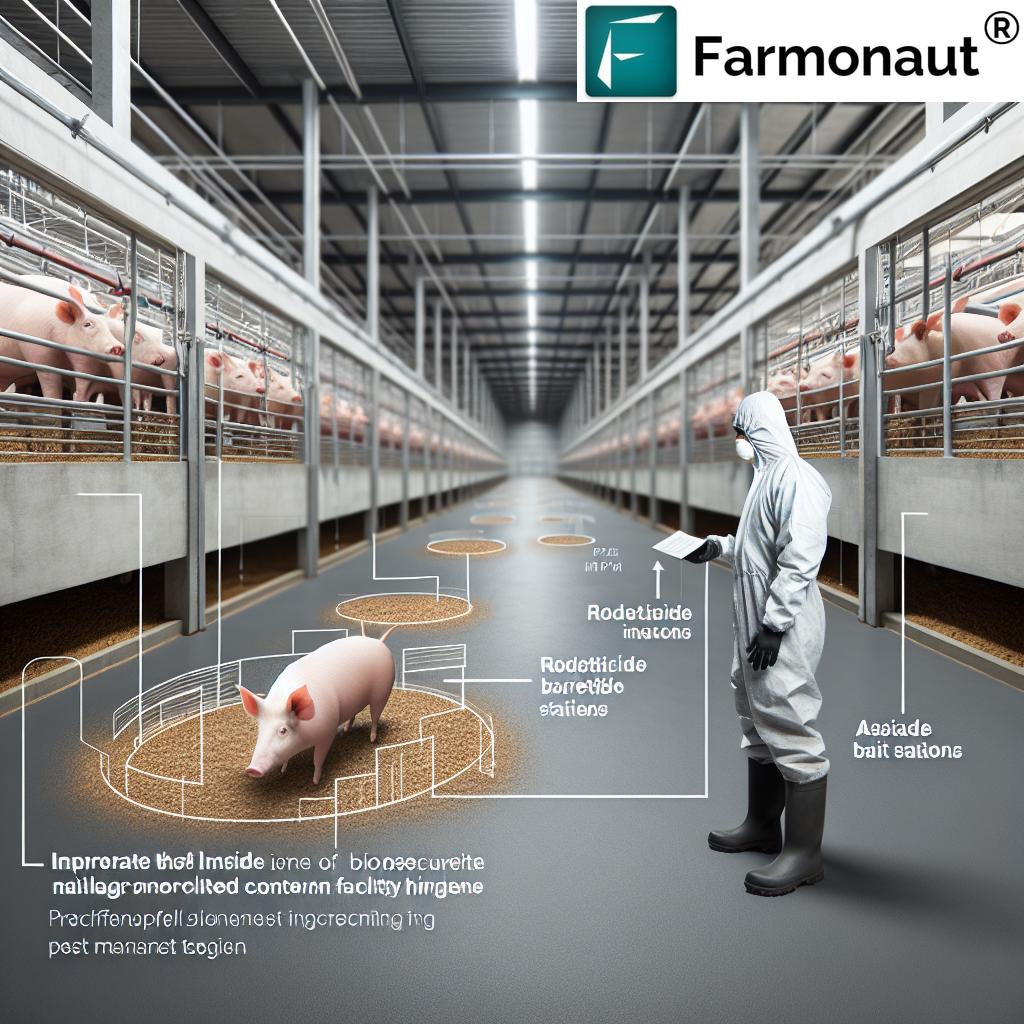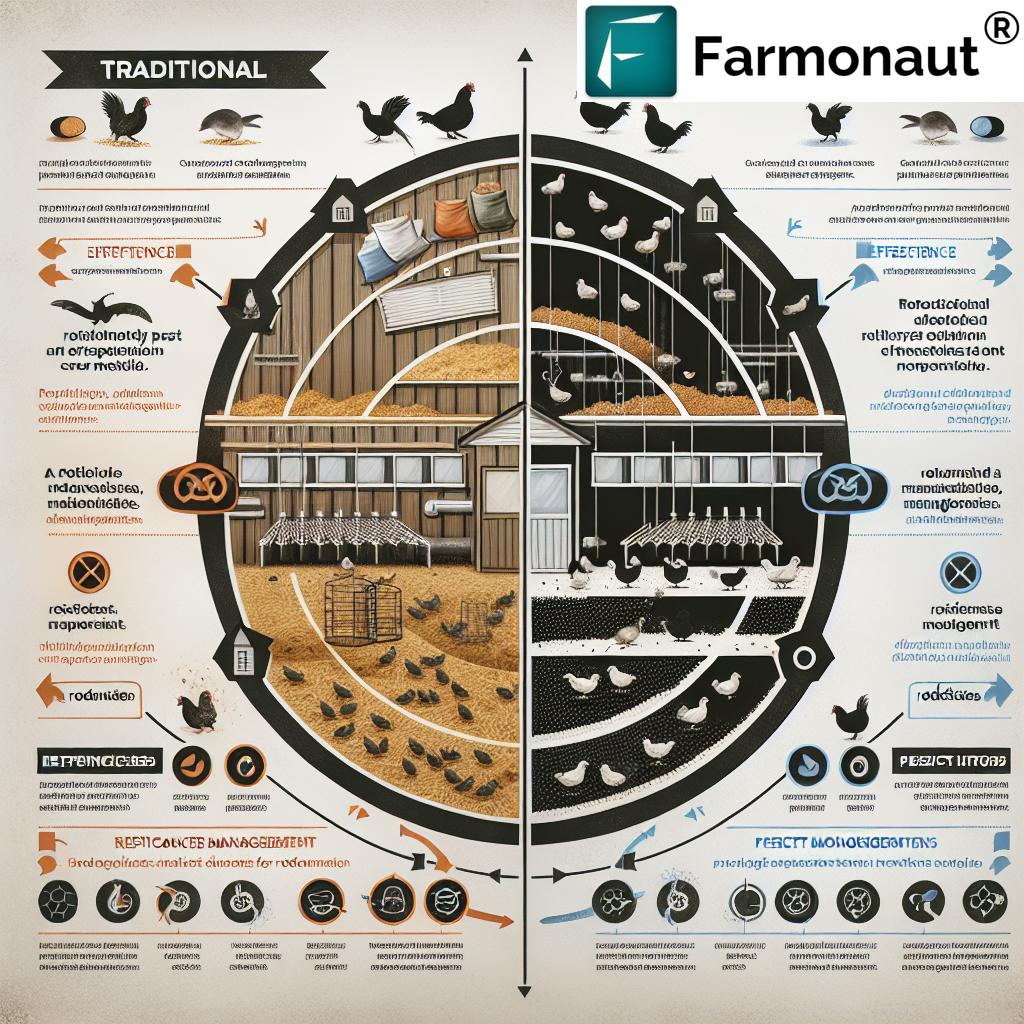Effective Rodent Control in Livestock Facilities: A Guide to Rotational Pest Management for Enhanced Biosecurity

“Bromethalin-based baits can eliminate rodents up to 4 times faster than traditional anticoagulant rodenticides.”
Welcome to our comprehensive guide on effective rodent control in livestock facilities. As experts in agricultural technology and farm management, we at Farmonaut understand the critical importance of maintaining robust biosecurity measures in swine and poultry operations. In this blog post, we’ll explore innovative solutions for pest management, focusing on advanced rodenticide technologies and rotational strategies that can significantly enhance your facility’s protection against harmful pests.
The Importance of Effective Rodent Control in Livestock Facilities
Rodents pose a significant threat to livestock operations, particularly in swine and poultry facilities. These pests not only cause direct damage to structures and equipment but also serve as vectors for numerous diseases that can devastate animal populations. Effective rodent control is, therefore, not just a matter of convenience; it’s a crucial component of maintaining biosecurity and ensuring the health and productivity of your livestock.
- Disease transmission prevention
- Protection of feed and infrastructure
- Maintenance of hygiene standards
- Compliance with regulatory requirements
At Farmonaut, while we don’t directly manufacture or sell pest control products, our satellite-based farm management solutions can help you monitor and manage your facilities more effectively, complementing your pest control efforts.
Advanced Rodenticide Technologies: A Game-Changer in Pest Management
The landscape of rodent control has evolved significantly in recent years, with the introduction of more effective and environmentally conscious solutions. One of the most notable advancements is the development of Bromethalin-based baits, which offer several advantages over traditional anticoagulant rodenticides.
Bromethalin vs. Anticoagulants: A Comparative Analysis
Bromethalin-based rodenticides represent a significant leap forward in pest control technology. Unlike anticoagulants, which work by preventing blood clotting and can take several days to be effective, Bromethalin acts on the central nervous system of rodents, leading to a much faster resolution of pest problems.
- Speed of Action: Bromethalin can eliminate rodents up to four times faster than anticoagulants.
- Resistance Management: The unique mode of action helps prevent the development of resistance in rodent populations.
- Reduced Secondary Poisoning: Lower risk to non-target animals due to its fast-acting nature.

Specialized Place Pacs: Enhancing Bait Effectiveness in Challenging Environments
Another innovative solution in rodent control is the development of specialized place pacs. These pre-measured bait packets are designed to withstand the harsh conditions often found in agricultural settings, ensuring that the bait remains effective and uncontaminated.
Benefits of Place Pacs in Livestock Facilities
- Moisture-resistant packaging
- Easy placement in hard-to-reach areas
- Reduced risk of bait contamination
- Precise dosage control
While Farmonaut doesn’t produce these pest control products, our advanced satellite imagery and AI-driven insights can help you identify potential problem areas in your facility, allowing for more targeted and effective placement of rodent control measures.
Rotational Pest Control Strategies: The Key to Long-Term Success
“Rotational pest control strategies can reduce rodenticide resistance by up to 90% in livestock facilities.”
Implementing a rotational pest control strategy is crucial for maintaining the long-term effectiveness of your rodent control program. This approach involves alternating between different types of rodenticides to prevent the development of resistance in rodent populations.
Key Components of an Effective Rotational Strategy
- Alternating between acute (e.g., Bromethalin) and chronic (e.g., anticoagulants) rodenticides
- Regular monitoring and assessment of rodent populations
- Adjusting bait placement and types based on observed rodent activity
- Integrating non-chemical control methods into the rotation
At Farmonaut, our satellite-based monitoring tools can provide valuable insights into the overall health and management of your livestock facilities, complementing your pest control efforts.
Optimizing Livestock Facility Sanitation for Enhanced Pest Control
Effective rodent control goes hand in hand with proper facility sanitation. A clean, well-maintained environment is less attractive to pests and can significantly reduce the need for chemical interventions.
Best Practices for Facility Sanitation
- Regular cleaning and disinfection of animal housing areas
- Proper storage and handling of feed and other inputs
- Maintenance of building structures to eliminate entry points
- Implementation of a comprehensive waste management system
Farmonaut’s API solutions can be integrated into your facility management systems, helping you track and optimize various aspects of your operations, including sanitation schedules and resource allocation.
Integrating Advanced Technologies in Pest Management
The future of pest control in livestock facilities lies in the integration of advanced technologies. While traditional methods remain important, new tools and approaches can significantly enhance the effectiveness of your pest management strategy.
Innovative Technologies in Rodent Control
- Smart traps with remote monitoring capabilities
- AI-powered pest detection systems
- Data analytics for predicting and preventing infestations
- IoT devices for real-time monitoring of bait stations
At Farmonaut, we’re at the forefront of agricultural technology. Our API Developer Docs provide information on how to integrate our satellite and weather data into your existing systems, potentially enhancing your ability to predict and manage pest-related issues.
Rotational Rodenticide Strategy Comparison
| Rodenticide Type | Active Ingredient | Mode of Action | Time to Effectiveness | Resistance Management Rating | Environmental Persistence | Recommended Usage Period | Ideal Placement Areas |
|---|---|---|---|---|---|---|---|
| Bromethalin-based | Bromethalin | Central Nervous System Disruptor | 1-2 days | 5/5 | Low | 4-6 weeks | Along walls, in corners, near feed storage |
| First-generation Anticoagulants | Warfarin, Chlorophacinone | Blood Clotting Inhibitor | 4-6 days | 3/5 | Medium | 6-8 weeks | Enclosed bait stations, burrow entrances |
| Second-generation Anticoagulants | Brodifacoum, Bromadiolone | Enhanced Blood Clotting Inhibitor | 3-5 days | 4/5 | High | 4-6 weeks | Secured bait stations, hard-to-reach areas |
Environmental Considerations in Rodent Control
While effective pest management is crucial, it’s equally important to consider the environmental impact of rodent control methods. Modern approaches aim to strike a balance between efficacy and ecological responsibility.
Eco-Friendly Pest Management Practices
- Use of targeted bait placement to minimize non-target species exposure
- Implementation of integrated pest management (IPM) techniques
- Regular collection and proper disposal of rodent carcasses
- Consideration of biological control methods where appropriate
At Farmonaut, we’re committed to promoting sustainable agricultural practices. Our  and
and  can help you monitor and manage your agricultural operations more efficiently, potentially reducing the need for intensive pest control measures.
can help you monitor and manage your agricultural operations more efficiently, potentially reducing the need for intensive pest control measures.
Training and Safety in Rodent Control Programs
Implementing an effective and safe rodent control program requires proper training and adherence to safety protocols. This is especially crucial in livestock facilities where the health of animals and workers is paramount.
Key Aspects of Rodent Control Training
- Proper handling and application of rodenticides
- Identification of rodent species and signs of infestation
- Safe disposal of dead rodents and contaminated materials
- Understanding and compliance with relevant regulations
While Farmonaut doesn’t provide direct pest control training, our platform offers  that can complement your pest management efforts by providing valuable insights into your overall farm management practices.
that can complement your pest management efforts by providing valuable insights into your overall farm management practices.
Measuring the Success of Your Rodent Control Program
To ensure the ongoing effectiveness of your rodent control efforts, it’s essential to establish a system for measuring and evaluating success. This allows for continuous improvement and adaptation of your pest management strategy.
Key Performance Indicators (KPIs) for Rodent Control
- Reduction in visible rodent activity
- Decrease in bait consumption over time
- Fewer reported incidents of rodent-related damage
- Improved overall hygiene scores in facility audits
Farmonaut’s advanced analytics can help you track and visualize various aspects of your farm’s performance, potentially providing insights that can be correlated with the success of your pest control efforts.
Regulatory Compliance and Documentation
Adhering to regulatory standards is a crucial aspect of rodent control in livestock facilities. Proper documentation and compliance not only ensure legal operation but also contribute to the overall effectiveness of your pest management program.
Essential Regulatory Considerations
- Compliance with local and national pest control regulations
- Proper record-keeping of rodenticide usage and placement
- Regular audits and inspections of pest control practices
- Adherence to guidelines for organic or specialty livestock production
While Farmonaut is not a regulatory body, our digital tools can assist in maintaining accurate records and documentation, which can be invaluable during audits and inspections.
Future Trends in Livestock Facility Pest Management
As technology continues to advance, the future of pest management in livestock facilities looks promising. Emerging trends point towards more integrated, data-driven approaches that combine traditional methods with cutting-edge technologies.
Emerging Trends in Pest Control
- Predictive analytics for early pest detection
- Drone-based monitoring of large facilities
- Genetic approaches to rodent control
- Integration of pest management with overall farm management systems
At Farmonaut, we’re constantly evolving our technology to meet the changing needs of the agricultural sector. Our satellite-based solutions and AI-driven insights are at the forefront of these advancements, helping farmers and livestock managers stay ahead of potential challenges, including pest management.
Conclusion: A Holistic Approach to Rodent Control
Effective rodent control in livestock facilities is a multifaceted challenge that requires a comprehensive, integrated approach. By combining advanced rodenticide technologies, rotational strategies, and innovative monitoring techniques, livestock operators can significantly enhance their biosecurity measures and protect their animals from harmful pests.
Remember, while products like Bromethalin-based baits and specialized place pacs are powerful tools in the fight against rodents, they are most effective when used as part of a broader pest management strategy that includes proper sanitation, regular monitoring, and ongoing adaptation to changing conditions.
At Farmonaut, we’re committed to supporting farmers and livestock managers with cutting-edge technology that complements these pest control efforts. Our satellite-based monitoring and AI-driven insights can help you maintain a comprehensive view of your operations, potentially identifying issues before they become serious problems.
By staying informed about the latest advancements in rodent control and leveraging technology to enhance your overall farm management practices, you can create a safer, more productive environment for your livestock. Together, we can work towards a future where advanced pest control strategies and innovative agricultural technologies combine to ensure the health and productivity of livestock operations worldwide.
FAQ Section
Q: How often should I rotate rodenticides in my livestock facility?
A: It’s generally recommended to rotate rodenticides every 4-6 weeks to prevent resistance development. However, this can vary based on the specific products used and the level of infestation.
Q: Are Bromethalin-based baits safe to use around livestock?
A: When used according to label instructions and placed in proper bait stations, Bromethalin-based baits can be safely used in livestock facilities. Always follow manufacturer guidelines and consult with a pest control professional.
Q: How can Farmonaut’s technology assist in rodent control efforts?
A: While Farmonaut doesn’t directly provide pest control products, our satellite-based monitoring and AI-driven insights can help identify potential problem areas, track facility conditions that might attract pests, and assist in overall farm management, which can complement your pest control strategies.
Q: What non-chemical methods can be integrated into a rotational pest control strategy?
A: Non-chemical methods can include traps, ultrasonic repellents, improved sanitation practices, and physical barriers. These can be rotated with chemical controls for a more comprehensive approach.
Q: How do I measure the success of my rodent control program?
A: Success can be measured through reduced visible rodent activity, decreased bait consumption over time, fewer incidents of rodent-related damage, and improved hygiene scores in facility audits.



